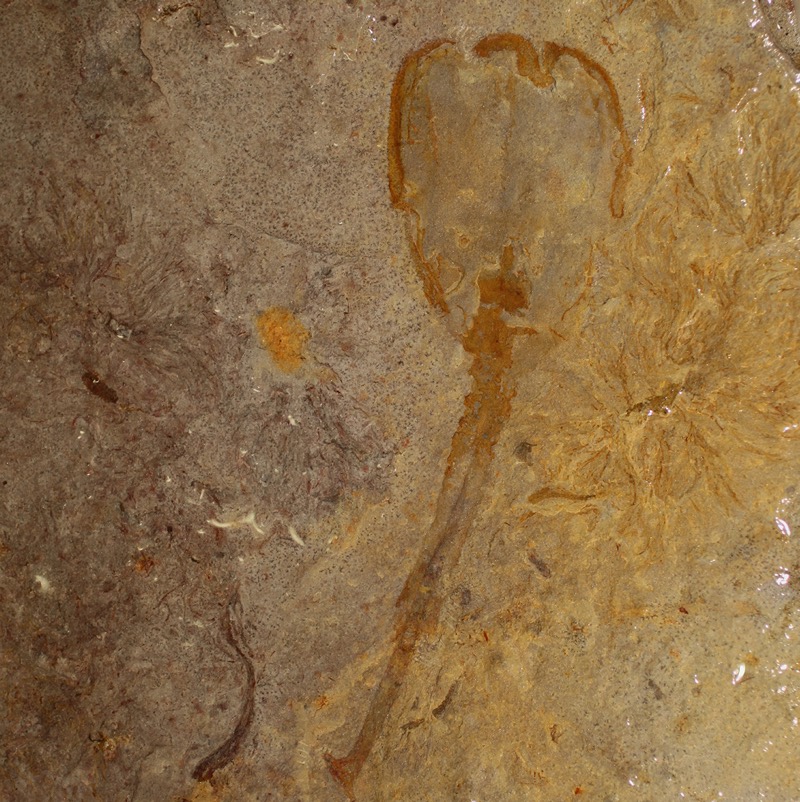Ancient Sea Creature Looked Like a Wine Glass, Died Alone

A solitary fossil unearthed in Utah's Antimony Canyon reveals a long-extinct marine creature previously unknown to science.
Resembling a dainty tulip bloom or an elegant white-wine glass, the 500-million-year-old bottom-feeder called Siphusauctum lloydguntheri looked uniquely ready for a romantic evening of sucking up microplankton along the seafloor. Sadly for the specimen, the world's only known example of S. lloydguntheri appears to have died alone, leaving no descendants past the end of the Cambrian period (541 million to 485.4 million years ago), possibly the victim of mass extinction.
Researchers at the University of Kansas' Biodiversity Institute described what little is known about the obscure invertebrate in a new paper published in the Journal of Paleontology. [Cambrian Creatures: Photos of Primitive Sea Life]
"Primitive and weird"
"The upper part of the tulip was the organism itself," lead study author Julien Kimmig, collections manager for Invertebrate Paleontology at the Biodiversity Institute at the University of Kansas, said in a statement. "It had a stem attached to the ground and an upper part, called the calyx, thathad everything from the digestive tract to the feeding mechanism. It was fairly primitive and weird."
Measurements show that the specimen was about 3 inches (9 centimeters) long, its narrow stem accounting for a little more than half that length. With no apparent body parts to aid it in swimming, S. lloydguntheri likely rode the currents near the bottom of the sea, using its stem to anchor into soft sediment when it was time to stop for sustenance, Kimmig said.
As a filter feeder, S. lloydguntheri would have taken its meals by pumping water into its calyx, then filtering out tasty organic matter like microplankton before digesting that material and excreting the waste.
"It is enigmatic because we don't have anything living that is exactly like it," Kimmig said. "The closest thing to the lifestyle — but not a relative — would be crinoids, commonly called sea lilies."
Get the world’s most fascinating discoveries delivered straight to your inbox.
While it may have no living relatives, S. lloydguntheri does share a genus with another extinct filter feeder of the same period, named Siphusauctum gregarium. Discovered in 2012 in Canada's Burgess Shale deposit, S. gregarium shares S. lloydguntheri's bottom-feeding lifestyle and would look equally at home in the barware section of Crate & Barrel (the common name Siphusauctum comes from the Latin word "siphus," meaning "cup" or "goblet").
There are some small differences between the species' internal organs, but the most mysterious difference between the two organisms is in the number of known specimens. While large communities of S. gregarium samples have been unearthed in Canada, only this single sample of S. lloydguntheri has been discovered, despite 60 years of studying the surrounding shale deposits in Utah. Based on floating algae fossils located next to S. lloydguntheri's imprint, researchers concluded the specimen was likely carried by currents away from its community.
A window into the Cambrian explosion
S. lloydguntheriis named for notable fossil hunter Lloyd Gunther, who donated the shale specimen to the University of Kansas in 1976, in addition to thousands of other samples over the years. The specimen is vividly preserved in a piece of Spence shale, a fine-grained rock found in Utah and Idaho that is especially kind to soft-bodied fossils. Samples such as these provide incredible glimpses into what paleontologists call the Cambrian explosion, one of the most rapid diversifications of life in Earth's history.
"Nearly every animal that we have around today has a relative that already lived during those times in the Cambrian," Kimmig said. "We have some lineages, like worms, that lived long before the Cambrian and haven't changed in appearance or behavior. Then we have things [like S. lloydguntheri] that were around for a couple of million years and just disappeared because they were chance victims of mass extinctions."
Raise a wine glass to that.
Original article on Live Science.

Brandon is the space / physics editor at Live Science. With more than 20 years of editorial experience, his writing has appeared in The Washington Post, Reader's Digest, CBS.com, the Richard Dawkins Foundation website and other outlets. He holds a bachelor's degree in creative writing from the University of Arizona, with minors in journalism and media arts. His interests include black holes, asteroids and comets, and the search for extraterrestrial life.
 Live Science Plus
Live Science Plus





